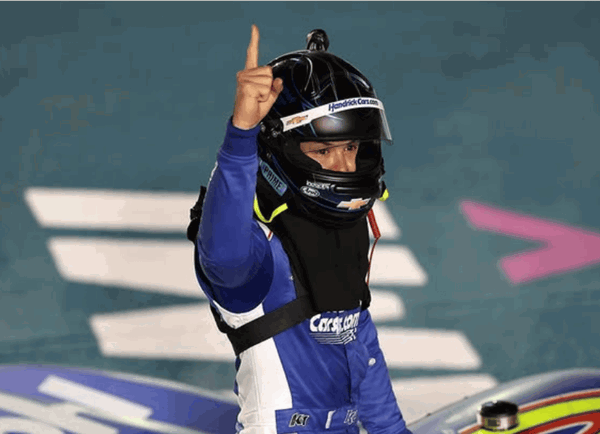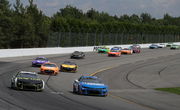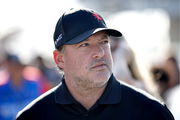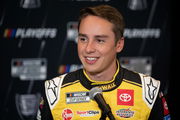

“We all know these Next Gen cars are terrible in traffic.” Denny Hamlin didn’t mince his words while sitting across the table from Dale Earnhardt Jr.. “They’re the worst cars in NASCAR in traffic.” He recalled trying to convince NASCAR three times before the aero package ever hit the track, but flawed testing produced a car where those consequences were bred in its bones. The result? A car that looked like it belonged in the future but broke under the demands of actual racing dynamics.
The next strange garage, with a different series’ banner, shows Kyle Larson discovering that progress isn’t free. Fresh after his return to the Indianapolis Motor Speedway for a second crack at the legendary Indy 500, Larson is seeing a new creature with hybrid power and setup unpredictability. After leaning against the wall ever so slightly, his car, the #17 Arrow McLaren Chevrolet, communicated some small but gnawing feelings: Dirty air? Hybrids don’t care about that.
ADVERTISEMENT
Article continues below this ad
Kyle Larson has a hybrid problem to solve
Coming off a promising 11th showing on a speed chart with a 223.430 mph lap, Larson did not sound like a panicky driver. Deep inside, his calm voice was just a subtle note of concern. “It feels a little different… I don’t know if it’s the hybrid stuff and the weight of that or what I’m feeling,” he told Helio Castroneves. Just that statement would send alarm bells ringing, especially given how much balance matters at IMS, where a slight wiggle at 220+ mph can put an end to a race before it’s even started.
It was supposed to be a smooth return for him. After all, he started fifth and finished 18th last year, getting all the experience he needed in his rookie run. But the addition of the new hybrid part to IndyCar this season has somehow moved the finish lines. All this new complexity brings a whole new set of variables- engine calibration to balance distribution, even a driver like Larson now has to find time to decode.
“Still, you know, a little rusty on things,” Kyle Larson admitted, “hitting buttons and trying to really, you know, get the dash set up… small detail things.” But the devil lives in the details, and in a 500-mile chess match like Indy, those details count. Even minor engine inconsistencies and radio issues during testing highlighted that the team is still figuring things out. They may be expected on day one, but by no means are they welcome. Well, Larson is not the only one who is feeling an almost neglected shift between Indy and mechanical personality.
What’s your perspective on:
Can Kyle Larson conquer the hybrid challenge, or is IndyCar's innovation too much to handle?
Have an interesting take?
Last year’s champion, Josef Newgarden, was recently taking special note of hybrid superiority being the defining factor this year. The advantages of using new kinetic energy recovery and electric boost are clear. But then again, they are for those who adapt quickly. “It’s about being efficient at the end of a stint,” Newgarden put it, “and that’s where races will be won or lost.” Quite motivating.
Every team is pushing the envelope of raw speed versus electronic proficiency. Hybrid power delivery interferes with the driver controlling everything from acceleration to tire wear and fuel mapping—all were previously tightrope worries back in the days before hybrid use. It is going to be quite a tough ride for Larson. Did you see him crash? But, at least fans found something great about the next-gen cars!
ADVERTISEMENT
Article continues below this ad
Trending
Future shock: NASCAR’s security blanket against Indy’s innovation
NASCAR’s Next Gen car has, despite its dirty-air problems, some acclaim for its enhanced safety features. Using Ansys simulations and other data, it has been proven to withstand “very high impacts” while keeping the driver safe. But, Hamlin posits, that protection came at the price of being able to race closely. So with hybrid integration looming over NASCAR’s own horizon, Larson’s misfortunes in Indy may serve as a caution.
The hybrid model of IndyCar is about much more than a green initiative; it is also about fair competition in a technology-driven world. NASCAR, which has long intertwined with electrification, is giving Indy a stern eye. Will they take heed of what Indy goes through before they make their own jump?
ADVERTISEMENT
Article continues below this ad
For Larson and the Arrow McLaren crew, it is going to be an entirely different test after a good night’s rest. “Anytime you’ve got a night to sleep on anything, you usually come back a little bit more comfortable,” he said in the hopeful tone of an optimist. Except comfort is not all; with hybrid systems being modified and setup sheets changing every hour, this day at IMS will be far more than just a refresh- it will be a reckoning.
Let’s hope Yung Money keeps up with the likes of Tony Stewart. All eyes are on him now, and he needs to take this opportunity seriously. But will he be able to make it? Let us know in the comments below.
ADVERTISEMENT
ADVERTISEMENT
ADVERTISEMENT
ADVERTISEMENT







Can Kyle Larson conquer the hybrid challenge, or is IndyCar's innovation too much to handle?